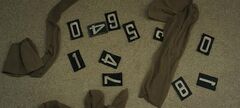Professor Philip Zimbardo designed an experiment. They found several students from Stanford University and promised them that they would be rewarded $15 each after a preset two-week experiment. Before the experiment, the staff conducted an interview evaluation of all of them, and finally used a coin toss to decide which of them would be guards and which would be prisoners.
Sounds like a lot of fun, but to make it more real, they use police cars to drive prisoners to pre-set prisons in the school like real arrests while they're still at home. However, the trial in court was omitted, and the prisoners were also asked to blindfold to increase their fear.
When the prisoners were sent to the converted prison, which was actually just a few rooms later, the students who became jailers because of the coin toss didn't know what to do at first. Taking the manuals given to them by the staff, they had the prisoners take off their clothes, change into prison uniforms, and put on ridiculous hats, and were sent to two rooms separately.
The guards each had a uniform and were given sunglasses, which gave them a dashing look and a stark contrast to the prisoners with ridiculous hats. The staff, especially Professor Zimbardo (everyone who studies psychology knows him, he has been to China not long ago, he is a living fossil of psychology and has written a lot of must-read textbooks for psychology majors) encourages the guards to manage prisoners with a sense of authority .
Contradictions soon emerged. Compared with the real prison, the virtual prison in this experiment was more rigorous and had few human rights. The prisoners—even though they didn't actually commit a crime, were just students participating in the experiment—the food was poor, even a little hard to swallow. Some boiled soybeans, with slices of bread. Personal items were confiscated, and even glasses for myopia were not allowed. The so-called cafeteria is just a narrow space outside the cell. The guards are still watching, and conversations are not allowed during meals.
Soon, the students serving as the warden began to have fun with the prisoners, asking them to report their numbers in various ways, and they were punished if they reported the wrong number. Dissatisfied prisoners will be locked in a small dark room. The other jailers joked with the warden, saying that he had the style of a killer in a certain movie, and the warden looked at himself in the mirror and gradually revealed a fierce expression.
At first, some prisoners couldn't take it anymore. They discussed in the cell, why the same $15, the guards can easily watch them, and they have to suffer so much? Others defended the guards, saying they were just doing their job, not trying to make things difficult for the prisoners. But the behavior of the guards began to escalate, especially against the rebellious prisoners. But there is still a trace of worry, after all, they know that this is just an experiment, and they don't know what step they can achieve with their own scale.
Professor Zimbardo (the professor's behavior in the film is an artistic process, don't combine it with the real Professor Zimbardo), gave the guards a reassurance, and shouted about his stomach in the face of a broken prisoner When the pain was overwhelmed, Professor Zimbardo believed that the jailers did not perform their duties well, otherwise how would any prisoners dare to resist. Once the professor's intentions were grasped, the guards began to reckon, spraying prisoners with dry ice, playing with them, and physically punishing them in turns.
But the prisoners, with the exception of a few or two, showed amazing cooperation. Maybe at the beginning, the guards felt a little fussy, but when the guards started imposing harsh punishments, the prisoners panicked. They no longer adhere to their original ideas, and they are respectful when talking to the guards, especially the warden. When eating, keep silent; when gathering, cooperate with the humiliating demands of the jailers to complete their inexplicable punishment.
We often think that our attitude determines our behavior, but our behavior also changes our attitude. Let's skip the movie for a moment to see an example of hypnotism, when the hypnotist says to someone during hypnosis that you need to take your shoes off when the book falls on the floor. After hypnotizing the person to wake up the person, the hypnotist deliberately dropped the book on the ground, and the other person immediately dragged his shoes. The hypnotist will ask the other person why you are slippers, and the answer is often an explanation given by the person because of his behavior. For example, I feel hot, or the shoes are not very comfortable, etc. Because with behavior, we will find a reason for our behavior, and this reason is our attitude. More psychological experiments have confirmed the efficacy of self-persuasion , with attitudes following behavior.
Going back to this simulated prison movie, when prisoners are asked to perform behaviors consistent with the identities they play, attitudes that they didn't think would be present before entering the experiment, this time comes. On the third day, visiting day, when prisoners talked to their family members who came to visit them, they began to think and talk like real prisoners , and they refused the family's suggestion to take them away.
There is another effect in psychology called the threshold effect . When you want someone to do you a big favor, but you're worried that the other person will say no, ask for a small favor first. If the other party agrees to help you with this small favor, once the behavior is done, and you offer the relevant big favor, people will often no longer refuse your request. Suburban psychologists in Toronto and their collaborators found that donations to cancer groups were generally 46 per cent. But if a small donation-related pin is given out to residents of the area the day before and is expected to be worn by everyone, the amount donated the next day will be double that of the previous day. If the person who did not approve of the donation originally, after wearing the small pin for publicity, will start to change his previous concept because of his own behavior.
The law that behavior determines attitude also leads, of course, to unethical behavior, and evil comes from escalating commitments. The guards gradually gained a sense of authority from the submissive behavior of the prisoners, and the prisoners also found reasons for their obedience and were more likely to accept worse treatment later. Professor Zimbardo's colleagues chose to leave one by one. They and the professor said that they were no longer observers of this experiment and began to become part of the experiment. The professor's girlfriend also told the professor that the prisoners had done something wrong to be treated like this, that they were just children and that there was no real crime. In the end, only the professor was left, sitting in front of the monitor, watching the experimental participants who were originally students intensify. At the last moment, the professor called to stop the experiment.
The film is based on a mock prison experiment devised by Stanford psychology professor Philip Zimbardo, who wonders whether the evil inmate or the vicious guard is responsible for the cruelty of the prison, or just because of the prison The system can lead to human cruelty. The real experiment, originally planned for two weeks, had to be abandoned on the sixth day. Professor Zimbardo wrote in his 1972 report: " People are becoming more and more confused between reality and hallucinations, roles and identities... This prison created... is passing through us. , making us its puppets ."
If you want to join the movie psychology reader group, please contact the platform assistant WeChat: xinliwanka, customs clearance password: I am a reader. If you think our article is still a little interesting, maybe you can give some suggestions and help, welcome to like and forward, or reward and support the main creator. If you want to know more about the main creator, you can follow Weibo: Psychological consultant Jia Rui.
View more about The Stanford Prison Experiment reviews











